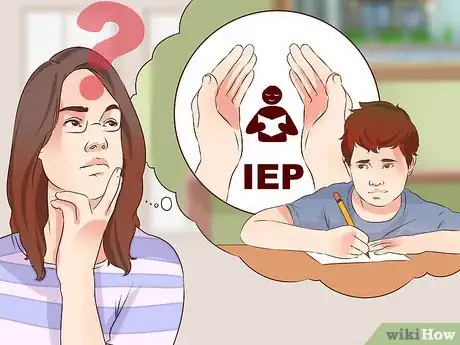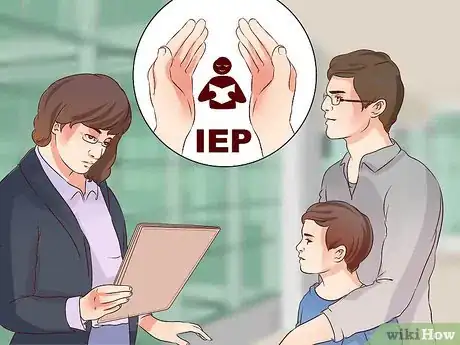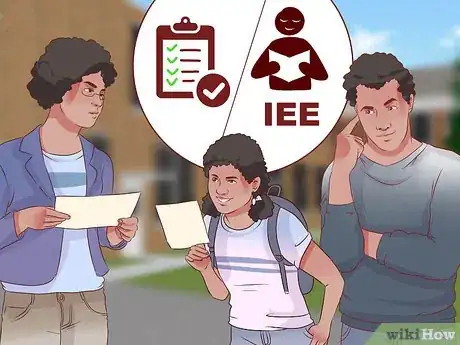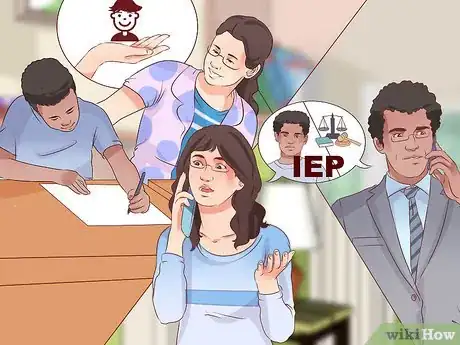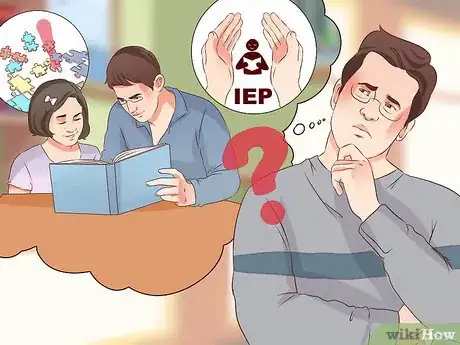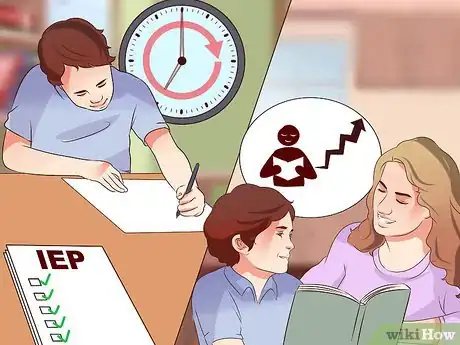This article was co-authored by Trudi Griffin, LPC, MS. Trudi Griffin is a Licensed Professional Counselor in Wisconsin specializing in Addictions and Mental Health. She provides therapy to people who struggle with addictions, mental health, and trauma in community health settings and private practice. She received her MS in Clinical Mental Health Counseling from Marquette University in 2011.
There are 8 references cited in this article, which can be found at the bottom of the page.
This article has been viewed 41,958 times.
IEP stands for individualized education programs. An IEP outlines special services and accommodations that are required to help a child succeed in school. There is no charge to families who need to have a child assessed for an IEP or for the services that a child will need to accommodate the child's disability.[1] If you are the parent or teacher of a child with a known or suspected disability, then there are several things you can do to get the child the help that they need.
Steps
Obtaining an IEP for Your Child
-
1Determine if your child may be eligible for an IEP. There are several disabilities that may make your child eligible for an IEP. If your child has already been diagnosed with a disability, then you can use this diagnosis as a reason why an IEP is necessary. Some disabilities that may qualify your child for an IEP include:[2]
- learning disabilities
- attention deficit hyperactivity disorder (ADHD)
- emotional disorders
- cognitive challenges
- autism
- hearing, vision, or speech impairment
- developmental delays
-
2Schedule a conference with your child's teacher. To get the IEP process started, you will need to schedule a conference with your child's teacher. During this meeting, you can express your concerns about the challenges your child has been having with school.[3]
- Keep in mind that your child's teacher may or may not be aware of your child's struggles. You might start by saying something like, “I am not sure if you have noticed anything unusual in the classroom, but here's what I have noticed at home…”
- Your child's teacher may also recommend a conference that includes your child, an observation of your child, and an evaluation of school work that your child has produced.
Advertisement -
3Decide if you would like to have your child assessed. If you have concerns about your child's performance in school and you think they would benefit from an IEP, then you can request to have your child assessed. There is no cost to have your child assessed. Your child will be assessed by specialists in the school system, which may include a:[4]
- psychologist
- physical therapist and/or occupational therapist
- speech therapist
- vision or hearing specialist
- special education teacher
- any other specialists who may be able to evaluate your child's needs
-
4Get an IEE if you disagree with the evaluation. You have the right to take your child for an Independent Educational Evaluation (IEE) if you do not agree with the findings of your child's evaluation. The person who evaluates your child can request that the school system pay for the evaluation.[5]
- Do not hesitate to get a second opinion if you think that the school's assessment is incorrect. For example, if you disagree with the school's assessment of your child's hearing abilities, then you could take your child to a hearing specialist for a second opinion.
-
5Consider other additions to your child's IEP team. You have the right to add other members to your child's IEP planning team if you choose to do so. This may include a specialist who has worked with your child or someone who works with your child outside of school, such as a coach. You can also hire an attorney to serve as an advocate for you and your child during the IEP planning process.[6]
- If you cannot afford an attorney, then the school system can provide one for you.
-
6Attend the IEP meeting. All members of the IEP planning team are required to attend the IEP planning meeting. You are a member of this team, so you are entitled to attend the meeting.
- Keep in mind that your input is quite valuable since your know your child best. Speak up if you disagree with something someone says or if you have ideas about what would be the most helpful measures for your child.
- You have the right to have the meeting recorded if you provide written notice at least 24 hours before the meeting. You can provide this request to your child's school principal or to the special education chairperson.[7]
- Be sure to ask questions and express your concerns during the IEP meeting as well. For example, if something does not make sense to you, then you might say something like, “I am not sure that I understand what that means. Can you please clarify it for me?”
-
7Get a copy of your child's IEP. After the IEP has been drawn up, you are entitled to receive a paper copy of the plan. Make sure that you request on if you do not receive one within a week of the meeting.
- If you disagree with any aspect of the IEP, then you can also request mediation or a hearing. You can hire your own attorney for this process or ask to have one appointed to you if you cannot afford an attorney.[8]
-
8Have your child reevaluated every three years. To ensure that the IEP is providing the maximum benefit to your child, it is important for them to be reevaluated at least once every three years. This reevaluation will also identify whether your child still has the disability or if it has improved or become more severe.[9]
- Depending on the findings of the “triennial” reevaluation, your child's IEP may need to be adjusted.
Obtaining an IEP for a Student
-
1Consider reasons why a student might require an IEP. It is normal for kids to struggle sometimes. However, if you have noticed that a student is consistently struggling in the classroom, then they may benefit from an assessment to see if an IEP is necessary. You might recommend a child for an assessment if they:[10]
- require constant guidance to complete tasks.
- are getting poor grades in the class even though they are working hard.
- are showing extreme frustration with school work.
- cannot remember a process because they do not understand the logic behind the process.
- cannot remember things that you explained in class or in writing.
- cannot read, write, or do math even if the child has strong general knowledge.
- cannot communicate or process language effectively.
-
2Refer the child to your school's counselor or psychologist. If you have identified one or more reasons why an IEP assessment seems warranted, then you will need to refer the child to your school psychologist or counselor for an assessment.[11] The school counselor or psychologist will meet with the child and send a request to the child's parents to conduct an assessment.
- You may also need to meet with the parents to discuss your concerns and find out if they have noticed similar challenges at home. You might say something like, “I am concerned about the challenges that Billy has been having in the classroom. He is working hard, but I think that he might need some additional help.”
-
3Be aware of time limitations. As soon as the child's parents consent to an assessment, you and other members of the IEP team will only have 60 days to complete the IEP.[12] This is because not having an IEP plan in place will interfere with the child's ability to function in the classroom. Therefore, it is important to prioritize this process.
- If you are on the IEP team, then make sure that you do your part as soon as possible. This may include providing an evaluation of the child's classroom performance and/or behavior, assessing the child's ability to complete certain tasks, or holding a conference with the parents and child.
-
4Implement the IEP guidelines. After the guidelines have been approved by the IEP team, then you will need to implement these guidelines in your classroom.[13] The IEP guidelines may only require minor adjustments to the way that you provide instruction to the child, or they may mean that the child will need assistance from someone throughout the day.
- For example, the child may be allotted more time to complete tasks, so you might need to let them continue working for longer than other students. Or, a child might need someone with them throughout the day to provide assistance with tasks.
- You will also be responsible for measuring the child's progress and reporting to parents on the child's improvements in the classroom.
References
- ↑ http://kidshealth.org/en/parents/iep-teachers.html#
- ↑ http://kidshealth.org/en/parents/iep.html
- ↑ http://kidshealth.org/en/parents/iep.html#
- ↑ http://kidshealth.org/en/parents/iep.html#
- ↑ http://www2.ed.gov/parents/needs/speced/iepguide/index.html
- ↑ http://kidshealth.org/en/parents/iep.html#
- ↑ http://www.uft.org/teaching/individualized-education-programs
- ↑ http://kidshealth.org/en/parents/iep.html#
- ↑ http://www2.ed.gov/parents/needs/speced/iepguide/index.html
